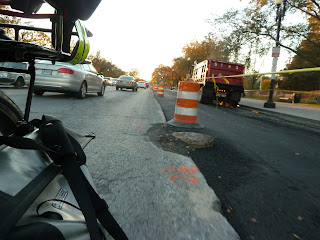I no longer ride competitively. I haven't for many years. I do, however, enjoy endurance events where my only competition is with myself. My 2011 riding season is over... and by that I mean that I have no more events to ride. I achieved every goal I set out to and had possibly the best season of riding ever.
That said, I still ride every day... and I go for a long training ride on Sundays. The rides are usually a little more casually paced and incorporate something fun along the way, but they're no less an important part of my preparation for next season. That's where the cargo bike comes in.
Riding a bike that weighs close to 90 pounds on a training ride has been an important part of building power and endurance in my riding over the last few years. Early in 2010 I had a bad fall and severely injured my shoulder. I was off the bicycle for 8 weeks at a time when I am normally putting in heavy base miles. Three weeks after the injury I was able to ride a recumbent, but still found it difficult to put in the kind of training that I felt I needed to prepare for the year's cycling events.
When I got back on the bike, it was the cargo bike that was my first choice. Every hour spent riding it was like spending an hour in a mobile weight room. My legs had to work significantly harder to accelerate. My upper body and core were worked similarly to sprint, climb and maneuver the bike through turns. I put 1500 miles on the Big Dummy in less than 2 months and felt ready for my first event for the year. The base I built on the Big Dummy served me well for the whole summer and fall riding season. I don't think I could have done that with a conventional bike.
So when I hung up my short bikes after the 2011 version of Stupid Human Tricks (I'll write about those in a post in the next few days) I was looking forward to getting out the cargo bike and getting back to basics.
One thing that I've found is very important when putting so many miles on the cargo bike... especially miles that include intervals and climbing... REST! Spending that much time intensely working the big muscle groups in the body definitely takes its toll. It is important to listen to your body and take it easy when you find yourself tired and lacking power at the beginning of a ride. I also keep an eye on my waking heart rate. If it is elevated noticeably, it can be a sign that I need a rest day. I always listen.
If my body isn't complaining, I keep piling on the miles. Off-season intervals are usually long ones where I'm stressing power over aerobic capacity. Climbing is done at a pace that I can maintain, instead of trying to push into the red all the time. Most important is to have fun on the rides. I often stop mid-ride, pull the long board off the back of the cargo bike and skate for 30-60 minutes as an alternative workout. I've been known to pack the running shoes on board and toss in a run in the middle of a ride too. Both of those are easy to do with the cargo bike, but not so easy on a carbon road bike.
So there you have it... The cargo bike makes for a fun training partner and delivers great results. I'd been trying to lose a little more weight all season... just 8-10 pounds would be nice. I've been back on the cargo bike for just over 2 weeks now and I've already lost 8 pounds. These are half of the stubborn "last 15 pounds" that I've wanted to lose for a while. I know the next 8 will not be easy, but my big, dumb training partner will be a big help.
Looking forward to posting up the plot of tomorrow's training ride.
Rock on, peoples.
Pete







